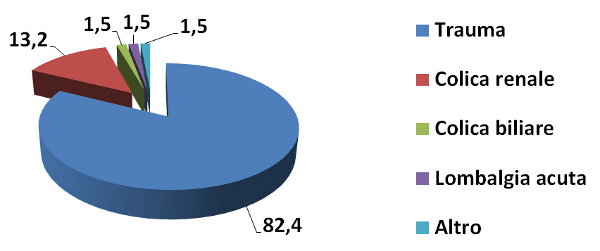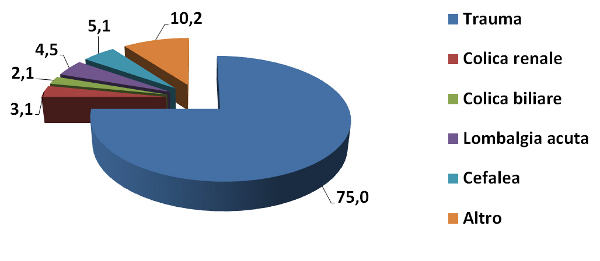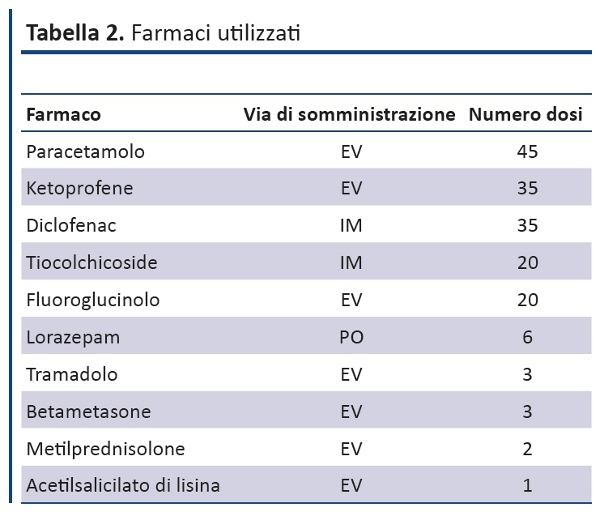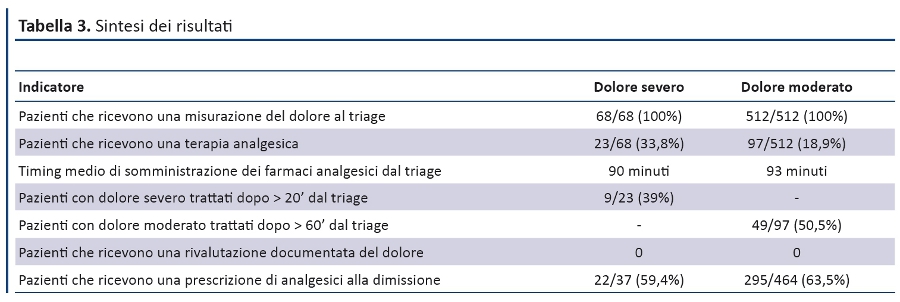Oligoanalgesia in pronto soccorso: da un audit retrospettivo a un percorso clinico-assistenziale
Ricerca originale
Oligoanalgesia in pronto soccorso: da un audit retrospettivo a un percorso clinico-assistenziale
Edoardo Pennacchio, Donato Summa, Michele AutilioEvidence 2012;4(4): e1000013 doi: 10.4470/E1000013
Ricevuto: 7 maggio 2012 Accettato: 6 giugno 2012 Pubblicato: 28 agosto 2012
Copyright: © 2012 Pennacchio et al. Questo è un articolo open-access, distribuito con licenza Creative Commons Attribution, che ne consente l’utilizzo, la distribuzione e la riproduzione su qualsiasi supporto esclusivamente per fini non commerciali, a condizione di riportare sempre autore e citazione originale.
1. Wilson JE, Pendleton JM. Oligoanalgesia in the emergency department. Am J Emerg Med 1989;7:620-3.
2. Selbst SM, Clark M. Analgesic use in the emergency department. Ann Emerg Med 1990;19:1010-3.
3. Rupp T, Delaney KA. Inadequate analgesia in emergency medicine. Ann Emerg Med 2004;43:494-503.
4. Stalnikowicz R, Mahamid R, Kaspi S, Brezis M. Undertreatment of acute pain in the emergency department: a challenge. Int J Qual Health Care 2005;17:173-6.
5. Curtis LA, Morrell TD. Pain management in the emergency department.
6. Tanabe P, Buschmann M. A prospective study of ED pain management practices and patient’s perspective. J Emerg Nurse 1999;25:171-7.
7. Cordell WH, Keene KK, Giles BK, Jones JB, Jones JH, Brizendine EJ. The high prevalence of pain in emergency medical care. Am J Emerg Med 2002;20:165-9.
8. Guru V, Dubinsky I. The patient vs. caregiver perception of acute pain in the emergency department. J Emerg Med 2000;18:7-12.
9. Harrison A. Comparing nurses’ and patients’ pain evaluations: a study of hospitalized patients in Kuwait. Soc Sci Med 1993;36:683-92.
10. Silka PA, Roth MM, Moreno G, Merrill L, Geiderman JM. Pain scores improve analgesic administration patterns for trauma patients in the emergency department. Acad Emerg Med 2004;11:264-70.
11. Todd KH, Funk KG, Funk JP, Bonacci R. Clinical significance of reported changes in pain severity. Ann Emerg Med 1996;27:485-9.
12. Bijur PE, Silver W, Gallagher EJ. Reliability of the visual analog scale for measurement of acute pain. Acad Emerg Med 2001;8:1153-7.
13. Bijur PE, Latimer CT, Gallagher EJ. Validation of a verbally administered numerical rating scale of acute pain for use in the emergency department. Acad Emerg Med 2003;10:390-2.
14. Berthier F, Potel G, Leconte P, Touze MD, Baron D. Comparative study of methods of measuring acute pain intensity in an ED. Am J Emerg Med 1998;16:132-6.
15. Rat P, Jouve E, Pickering G, Donnarel L, Nguyen L, Michel M et al. Validation of an acute pain-behavior scale for older persons with inability to communicate verbally: Algoplus. Eur J Pain 2011 Feb;15:198.e1-198.e10.
16. Zoltie N, Cust MP. Analgesia in the acute abdomen. Ann R Coll Surg Engl 1986;68:209-10.
17. Attard AR, Corlett MJ, Kidner NJ, Leslie AP, Fraser IA. Safety of early pain relief for acute abdominal pain. BMJ 1992;305:554-6.
18. Pace S, Burke TF. Intravenous morphine for early pain relief in patients with acute abdominal pain. Acad Emerg Med 1996;3:1086-92.
19. Thomas SH, Silen W, Cheema F. Effects of morphine analgesia on diagnostic accuracy in emergency department patients with abdominal pain: a prospective randomized trial. J Am Coll Surg 2003;196:18-31.
2. Selbst SM, Clark M. Analgesic use in the emergency department. Ann Emerg Med 1990;19:1010-3.
3. Rupp T, Delaney KA. Inadequate analgesia in emergency medicine. Ann Emerg Med 2004;43:494-503.
4. Stalnikowicz R, Mahamid R, Kaspi S, Brezis M. Undertreatment of acute pain in the emergency department: a challenge. Int J Qual Health Care 2005;17:173-6.
5. Curtis LA, Morrell TD. Pain management in the emergency department.
6. Tanabe P, Buschmann M. A prospective study of ED pain management practices and patient’s perspective. J Emerg Nurse 1999;25:171-7.
7. Cordell WH, Keene KK, Giles BK, Jones JB, Jones JH, Brizendine EJ. The high prevalence of pain in emergency medical care. Am J Emerg Med 2002;20:165-9.
8. Guru V, Dubinsky I. The patient vs. caregiver perception of acute pain in the emergency department. J Emerg Med 2000;18:7-12.
9. Harrison A. Comparing nurses’ and patients’ pain evaluations: a study of hospitalized patients in Kuwait. Soc Sci Med 1993;36:683-92.
10. Silka PA, Roth MM, Moreno G, Merrill L, Geiderman JM. Pain scores improve analgesic administration patterns for trauma patients in the emergency department. Acad Emerg Med 2004;11:264-70.
11. Todd KH, Funk KG, Funk JP, Bonacci R. Clinical significance of reported changes in pain severity. Ann Emerg Med 1996;27:485-9.
12. Bijur PE, Silver W, Gallagher EJ. Reliability of the visual analog scale for measurement of acute pain. Acad Emerg Med 2001;8:1153-7.
13. Bijur PE, Latimer CT, Gallagher EJ. Validation of a verbally administered numerical rating scale of acute pain for use in the emergency department. Acad Emerg Med 2003;10:390-2.
14. Berthier F, Potel G, Leconte P, Touze MD, Baron D. Comparative study of methods of measuring acute pain intensity in an ED. Am J Emerg Med 1998;16:132-6.
15. Rat P, Jouve E, Pickering G, Donnarel L, Nguyen L, Michel M et al. Validation of an acute pain-behavior scale for older persons with inability to communicate verbally: Algoplus. Eur J Pain 2011 Feb;15:198.e1-198.e10.
16. Zoltie N, Cust MP. Analgesia in the acute abdomen. Ann R Coll Surg Engl 1986;68:209-10.
17. Attard AR, Corlett MJ, Kidner NJ, Leslie AP, Fraser IA. Safety of early pain relief for acute abdominal pain. BMJ 1992;305:554-6.
18. Pace S, Burke TF. Intravenous morphine for early pain relief in patients with acute abdominal pain. Acad Emerg Med 1996;3:1086-92.
19. Thomas SH, Silen W, Cheema F. Effects of morphine analgesia on diagnostic accuracy in emergency department patients with abdominal pain: a prospective randomized trial. J Am Coll Surg 2003;196:18-31.








